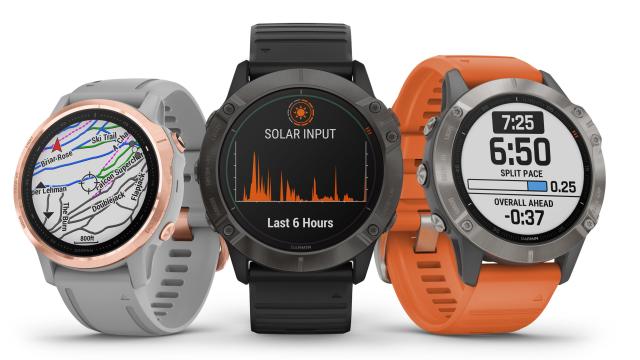There’s smartwatches that can do fitness, and then there’s fitness smartwatches geared toward that one super buff friend who reminds you every few months about the upcoming triathlon. Garmin’s made a name for itself making the latter. Thursday, it launched its fenix 6 series of smartwatches, and boy, they sure are beefy.
Leading the pack is the fenix 6X Pro Solar, which if you couldn’t guess by the name, features a transparent lens that doubles as solar power cell. You can also check how much solar energy you’ve soaked up directly on the wrist via a “Solar Input” screen. That translates to an estimated 21 days of battery life, plus 3 days from solar charging — assuming you’re outside at least three hours a day every day.
That number drops a bit to 15 hours of continuous GPS and music, but you’d have to be an outdoor fitness machine to zap that up in one go. This isn’t the first time we’ve seen an interesting battery charging mechanism in a smartwatch.
Matrix is known for using body heat to charge its smartwatches — to varying degrees of success — and its PowerWatch 2 will also have a solar cell.
The Pro Solar also sports a 1.4-inch display, a roughly 36 per cent increase from the fenix 5X. On top of the usual preloaded GPS and music storage, Garmin’s also adding Pulse Ox blood oxygen saturation tracking, which it uses to estimate body energy levels in combination with heart rate, sleep and activity data.
It’s also debuting a new PacePro feature. It’s basically an on-wrist guide for runners looking to improve their split times or run at a consistent speed.
Under the hood, Garmin is also updating its heart rate sensors to support all-day stress tracking, underwater heart rate for swimmers, advanced sleep monitoring, and heat-and-altitude adjusted VO2 max. And in the event you feel like buying some water after all that working out, it supports contactless payments via Garmin Pay.
That said, the 6X Pro Solar is rather chunky in person. To be fair, that makes sense as its meant to be a rugged outdoor companion and is jam-packed full of fitness features. Garmin’s aware of that, which is why the other smartwatches in the fenix 6 series are a tad smaller.
The fenix 6 features a 1.3-inch display. That’s 0.1 inches smaller than the Pro Solar, which is, as you can see in the above picture, makes for a sizeable difference on something like a wrist. The 6S shares the smaller display, but shrinks things down even further. It’s intended for people with smaller wrists. Otherwise there’s no real difference in features between the 6 series and the 6X Pro Solar, except for slightly shorter battery life and lower price point.
Speaking of moolah, these are not cheap smartwatches. Prices start at $949 for the fenix 6 and fenix 6S.
The fenix 6X, which is a step up in battery life but minus the solar charging, starts at $1,199. Meanwhile, the Pro Solar will retail for a whopping $1,549.
